| Date: 1944 Jan 11/11 | A/C Type: B-17G Fortress | SN: 42-37719 | Code: VP-L | A/C Nickname: Hellcat | 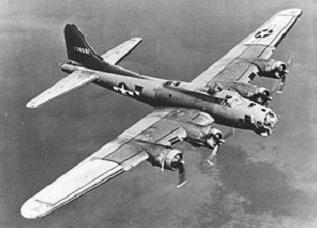 |
|||||
| File: 152 | Airforce: USAAF | Sqn/Unit: 381 BG - 533 BS | Mission/Raid: Oschersleben | |||||||
| 1 | Pilot | 2Lt. Donald E. Nason buried Hilversum | 9 | RWG | Sgt. Raymond C. Beus MIA | |||||
| 2 | Co-pilot | 2Lt. Joseph J. Byser buried Amersfoort | 10 | TG | Sgt. George A. Whitney MIA | |||||
| 3 | Nav. | 2Lt. Athan Anagnos buried Elburg | 11 | |||||||
| 4 | B | 2Lt. Charles D. Fiery buried Amsterdam | 12 | |||||||
| 5 | E | S/Sgt Luster T. Harrah buried Harderwijk | 13 | |||||||
| 6 | RO | S/Sgt. Ralph L. Lab MIA | 14 | |||||||
| 7 | BTG | Sgt. Paul W. Stonich MIA | 15 | |||||||
| 8 | LWG | Sgt. John "Jack" R. Lantz rescued, POW | 16 | |||||||
On route to target hit by Flak or fighters. Damage to engines. Turned back, crew jumped over Lake IJsselmeer (Old Zuyder Sea), only one survivor. Five crew washed ashore, four gunners MIA. Aircraft crash position found in 1966, parts recovered. |
||||||||||
Important (open) file with 4 MIA. Only survivor Sgt. "Jack" Lantz (Tulsa, Oklahoma): "Weather underway Oschersleben deteriorated, poor visibility." "Near Dutch-German border, heavy Flak or odd shots of German fighters severed oil lines to no. 3 engine. Pilot Nason feathered the propeller. No. 4 engine lost power. No. 2 engine started to cough and misfire. We lost power and lift. Nason had to drop out of formation and decided to turn back".
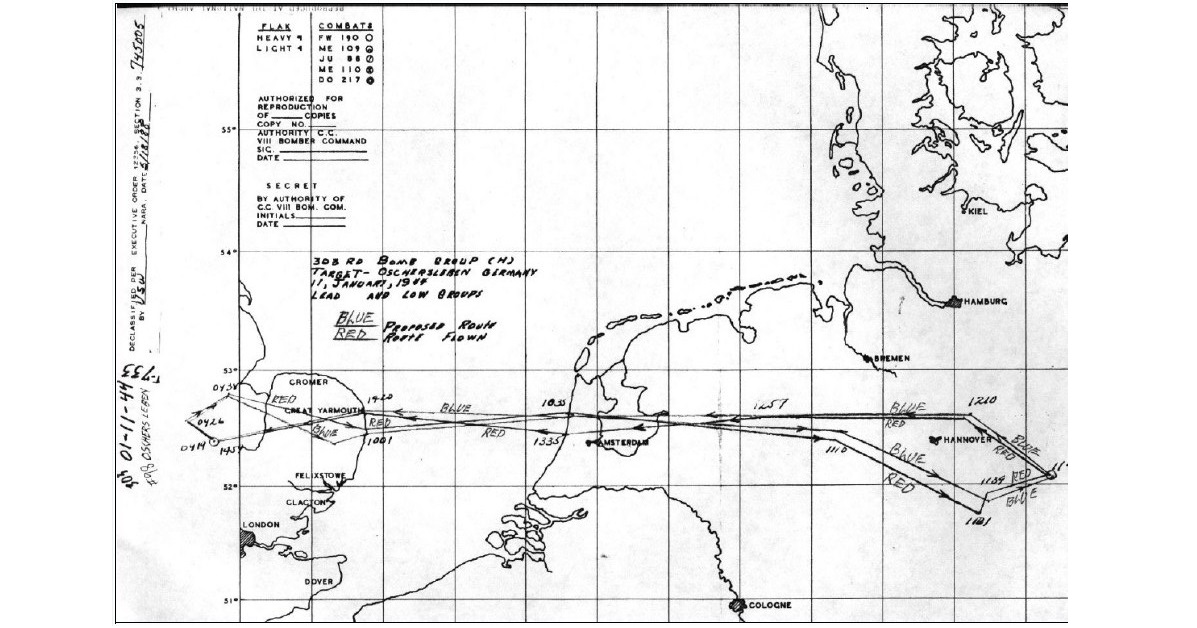
Crew Nason.
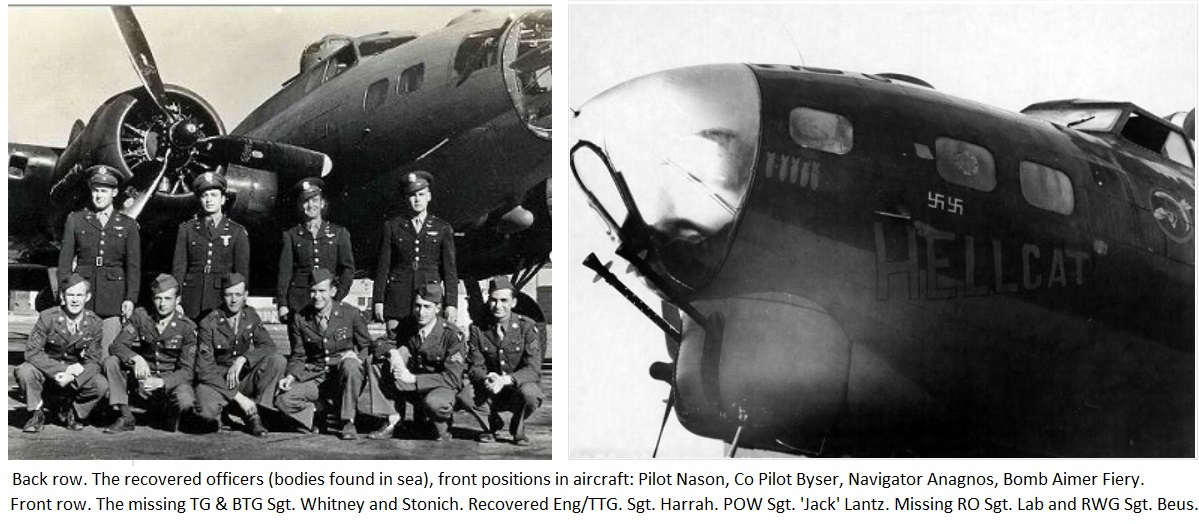
The formation B-17s saw Nason drop into the clouds below them and did not see Ship no. 42-37719 and crew again (below).
At the question mark, Nason went under the clouds and turned back in direction Great Yarmouth. Halfway the aircraft came down in Holland's central Lake IJsselmeer.
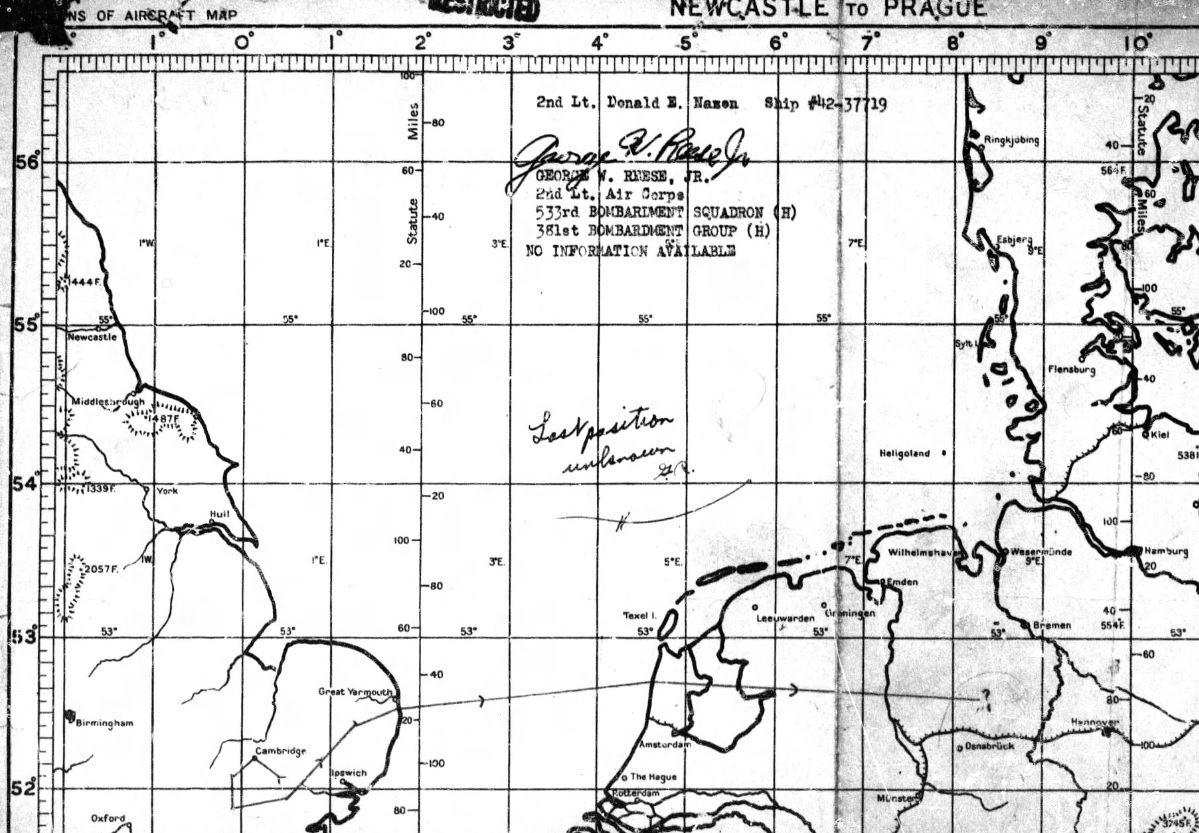
Lantz: "on the return the plane kept losing height" (ZZairwar: did they emergency release the bombs while still over Germany or later over the Lake?). "Some time later, Nason heard from bomb aimer Charles Fiery we were over water". Slowly they came under the bad weather clouds. "In the distance German fighters were looking for prey. The pilot wanted to get back up in the clouds for cover and ordered co-pilot Joe Byser to restart the feathered no. 3 engine. I (Lantz) saw it was covered with oil and it bursted into fire immediately. The next engine no. 4 was leaking fuel, a full burning right wing or exploding wing fuel tank was eminent. Nason gave the bail out order".
"I saw radio operator Sgt. Ralph Lab jump out feet first through the aft escape hatch in the floor, followed by Belly Turret Gunner Sgt. Paul Stonich and Right Waist Gunner Sgt. Ray Beus. I hesitated, called in on the intercom for the latest status, but no one replied. By now the plane was really falling down from the sky, with difficulty I could crawl towards the hatch and get out".
Lantz fell through the low clouds and pulled his ripcord. Under the clouds he saw other parachutes, but far off. Debris of the aircraft were smoking in the water. Hanging on his parachute he yelled for help into direction of two fishing boats (the BU -Bunschoten- 57, saw some 10 parachutes and turned to Lantz' position). On his left, a small Dutch harbor patrol police boat turned also towards the scene. On this boat were policemen Pronk and Kuit, underway from Spakenburg to Enkhuizen (black line below).
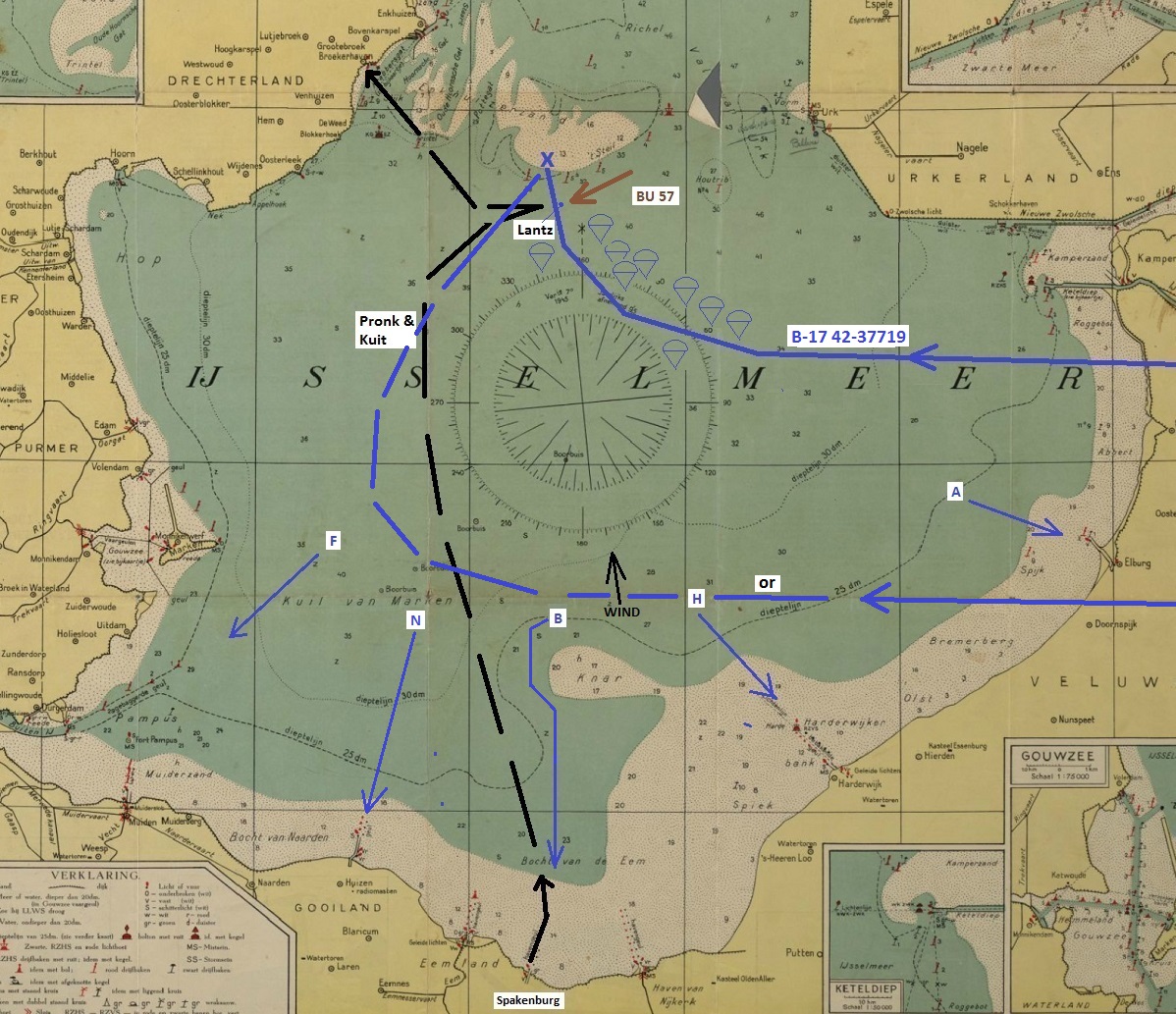
Lantz in the water, to Amsterdam prison.
As usual in these cases, the pre-war designed Mae West life jacket could not keep afloat the heavy 1944 winter flying suits and the men went under in the ice cold water. Lantz felt the freezing cold paralyzing him and his gear dragged him under. Two fishermen of the BU 57 rescued the 19 year old sergeant just in time. Bunschoter Johannes de Graaf removed Lantz' clothing, brought him downstairs and put him in front of the stove in a dry trousers and blanket. Lantz could not speak yet of exposure, but showed nine fingers and pointed outside. The fishermen had seen the parachutes coming down and understood that out in the choppy sea another nine men were fighting for their life. A search was made, but they were all gone.
The small harbor patrol boat came alongside the BU 57. Dutch policemen Pronk and Kuit took Lantz over. The fishermen went back to work, because they had floating nets (for Perch and Yellow Pike) in the water at de Val van Urk, these mobile nets needed urgent attention. Weather was foul and cold. Pronk gave Lantz an overall and wooden clogs. Lantz later stated that the policemen said they had to turn him in to the Germans, because no doubt the burning B-17 was observed and the Germans already searched. Pronk post war said to the press that his plan was to bring Lantz to shore and hand him over to the resistance. To accomplice that, course was not continued to Enkhuizen harbor, but to the smaller, quieter and more nearby Broekerhaven harbor. However, underway they were boarded by an armed patrol boat of the German WSP Water Police (Wasserschützpolizei).
The German WSP Wasserschützpolizei had a very bad reputation at this point in the war. Most regular German civilian policemen on board were gone, transferred into the German Army. The WSP was under direct command of the highest German Police Authority in Holland, which was the cruel SS General Hanns Albin Rauter. He filled the open positions in the WSP with most Dutch Waffen-SS volunteers and fanatic Dutch NSB collaborators. In Broekerhaven the WSP boat took Lantz over. A Dutch SS-man began shouting and threatening Lantz, but he did not understood a word a did not gave him any response. The German regular WSP-skipper intervened and told the SS-man to shut up. Then he ordered that the SS-er should hand over his oil skin overcoat to the prisoner. Lantz was walked to the Grootebroek or Bovenkarspel Flora train station in his fishermen trousers, covered by the police overall, in wooden shoes and in the WSP/SS-oil skin overcoat. When Lantz was in Amsterdam jail for interrogation by the German Sicherheitsdienst and later the Luftwaffe, policeman Pronk received back his overall and wooden shoes by post. The young gunner became POW (Heidekrug) and survived the infamous death marches in April 1945.
1966, recovered parts.
In 1966 the tail fin, a piece of rear fuselage and the belly turret where recovered from the Lake, in only 5 feet of water, on sand bank Enkhuizerzand. This was a simple salvage, the parts were simply hoisted up by a boat of the Dutch Department of Waterways (RWS) or a hired-in ship (de Poolster), it took only a few hours. At first it was reported that the tail showed a big 'C' in white triangle with '237719'. However, the C did not match the letter for the 42-37719 Hellcat's 381 Bomb Group, which was a big L in white triangle. Maybe this was a mistake by RNLAF spokesman and press-officer Capt. A.P. de Jong. He later stated in an interview that the aircraft was ex-303 Bomb Group, which had C in triangle, and that the C was overpainted with a L. After 22 years in the water the overpainted C came through again.
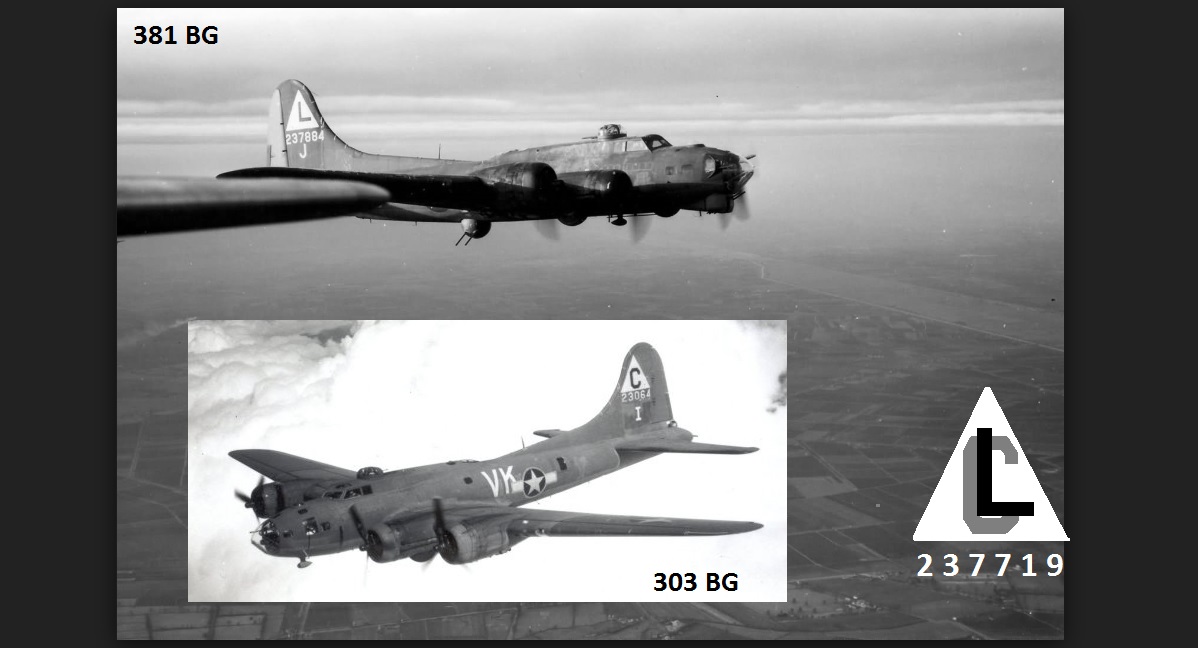
Veenstra
In the excellent Dutch book 'In de schaduw van de glorie' (In the shadow of the glory), 1992, by former Dutch RNLAF recovery team sergeant S.L. Veentra, it is mentioned on page 71 that in June 1966 the 42-37791 of the 381 BG was found in the Lake a few km east of Edam. This is an incorrect identification or typo, because this aircraft off Edam was the B-17 "Full House" 42-37773, crew Lt. Bull, 388 BG, 22 Dec. 1943. http://www.zzairwar.nl/dossiers/150.html
Lantz return to Holland in 1973
Almost 30 years after his parachute jump in Lake IJsselmeer, John Lantz contacted the RNLAF. He was in search for his rescuer and wanted to come over to visit and thank him. Newpapers picked up the story and after a few days fisherman Johannes de Graaf and police inspector Pronk were found. At first all eyes were focused on former fishermen Jaap and Klaas Kwakman (Bol) from Volendam. They had rescued in 1944 three airmen (from a B-24) in the same Lake-area and under simular circumstances. It had never became known who those three rescued airmen were (since year 2005 it is; crew Hubert Cripe: http://www.zzairwar.nl/dossiers/292.html ), therefore Jaap and Klaas were eager for contact, but Lantz was rescued alone, so his case was different.
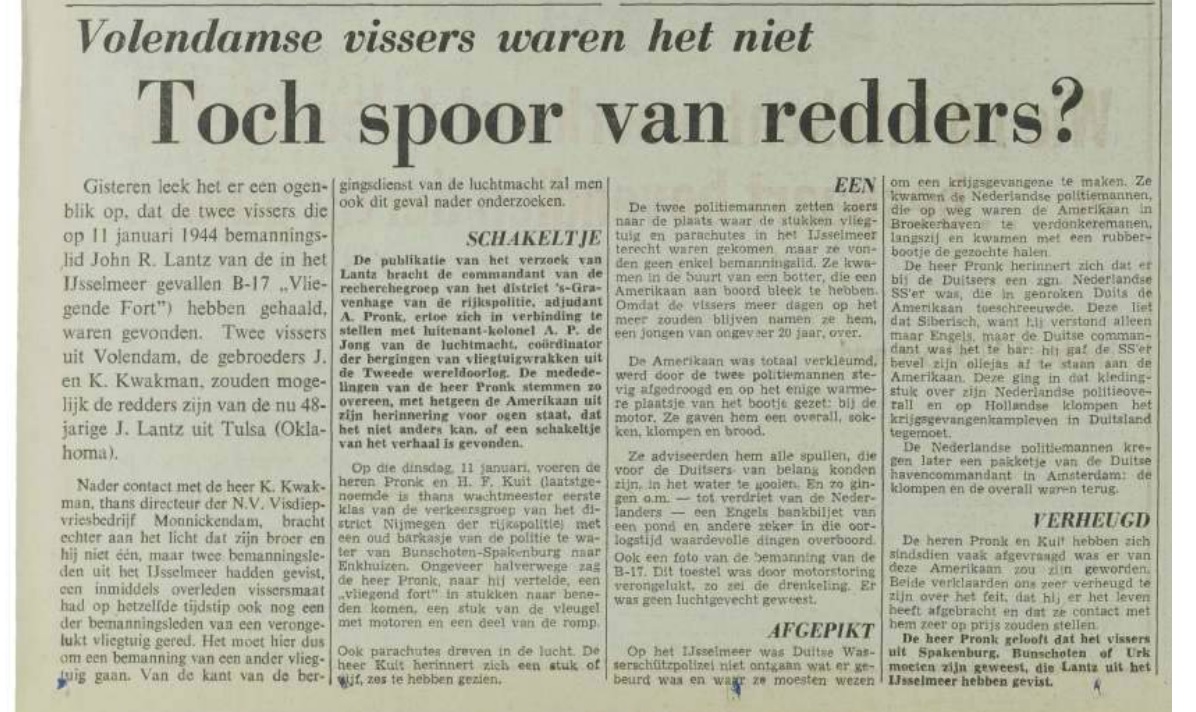
News paper comment Pronk 1973
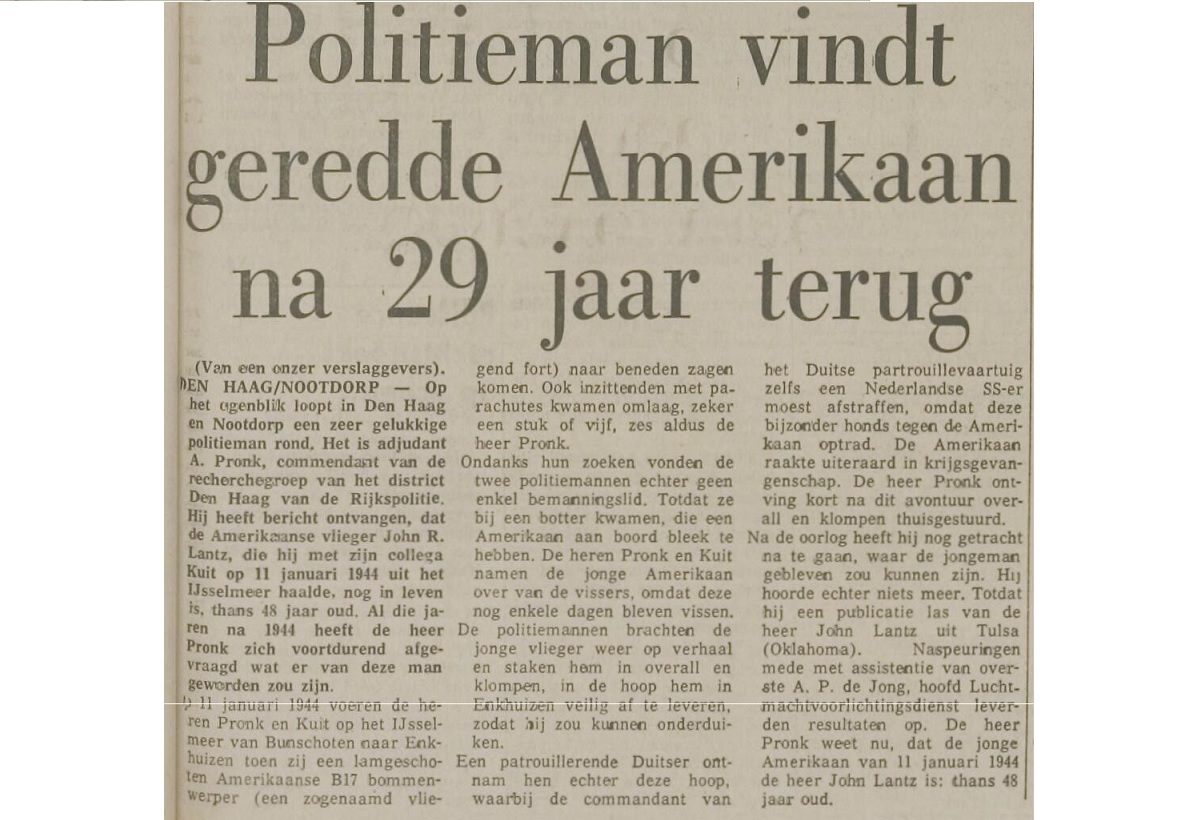
Below: in August 1973 John Lantz (48) met fisherman Johannes de Graaf (71) in Bunschoten-Spakenburg.
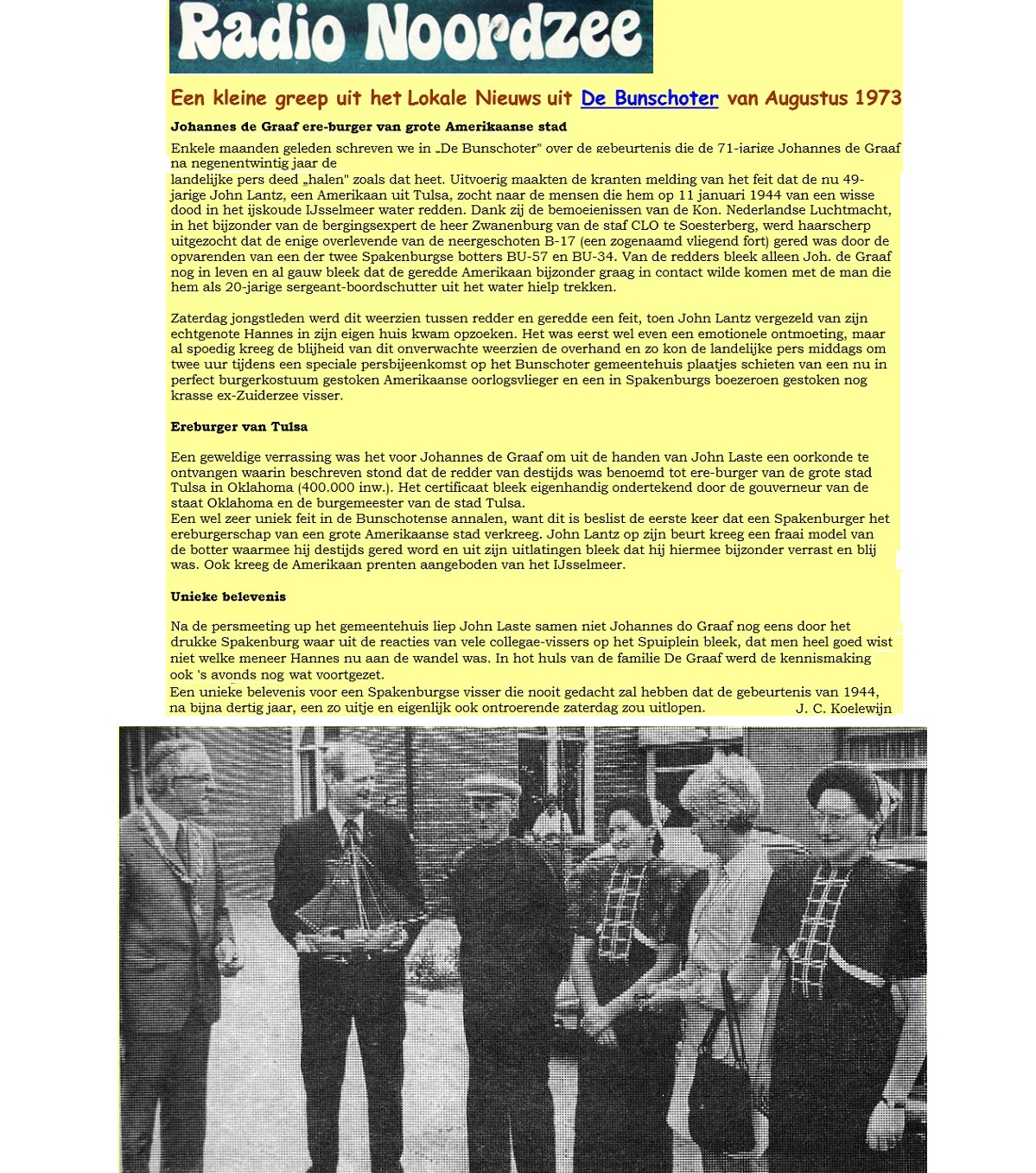
Where are the missing four sergeants?
In the months after 11 January 1944, the remains of the five men that had front positions in the aircraft were brought to a harbor:
the four officers and engineer S/Sgt. Luster T. Harrah. See their name indicated with a letter on above sea chart. Clockwise:
A. Navigator 2Lt. Athan Anagnos. Brought into fishing port Elburg. Buried in Elburg on July 12, 1944 (after 6 months).
H. Engineer S/Sgt. Luster Harrah. Brought into fishing port Harderwijk. Buried Harderwijk as unknown airman. Identified in 1945.
B. Co-pilot 2Lt. Joseph Byser. Brought into fishing port Spakenburg. Buried in Amersfoort as unknown airman. Identified in 1945.
N. Pilot 2Lt. Donald Nason. Brought into fishing port Huizen. Buried in Hilversum on March 20, 1944.
F. Bombadier 2Lt. Charles D. Fiery. Brought to Amsterdam port. Buried Amsterdam as unknown English airman (without head) on April 25, 1944. ID in 1945.
Missing: Sgt. Ralph Lab, Sgt. Paul Stonich, Sgt. Ray Beus and Sgt. George Whitney.
All crew bailed out and used their parachute. We expect that the missing four also were brought to the Lake shore in the period January 12- October 1944 and were buried locally as unknown airman. For example the unknown American airman buried after Lt. Fiery in Amsterdam on 28 April 1944. They were recognized based on their clothing as USAAF in the 1945-1947 identification process. Transferred to the American Identification Centre in Neuville-en-Condroz (Belgium) for further identification, but this was unsuccessful. Buried with cross 'Here rests in honored Glory a Comrade in Arms Known but to God'. Cemetery named today American Cemetery Ardennes in Neupré.
===============
Read more/links:
- Lantz http://www.tulsaworld.com/archives/world-war-ii-remembered-wwii-flier-recalls-ordeal/article_77dd6618-dd32-5b5d-b519-948a572312c8.html
- Lantz http://www.krmg.com/news/news/local/tulsa-man-was-sole-survivor-when-his-bomber-went-d/nYCn9/
- Lantz http://www.garykelleyafs.com/memsol.cgi?page=profile§ion=info&user_id=1893437
- Nason and crew: https://www.findagrave.com/cgi-bin/fg.cgi?page=gr&GRid=56302202
Thanks to website Losgoud.nl (Lokale Omroep Spakenburg).
© ZZairwar (Zuyder Zee Air War)
.